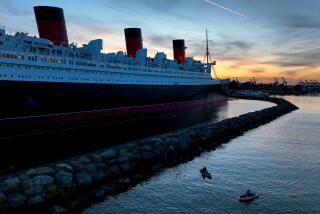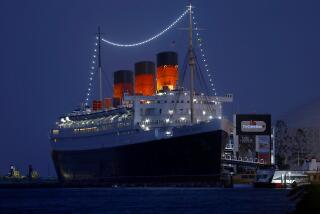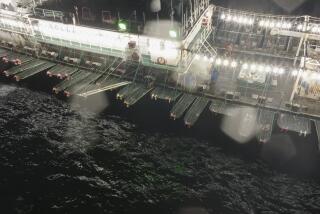Many Ships Charged With Sanitation Violations
- Share via
In late March the twice-a-month green sheet mailed out from the U.S. Department of Public Health to travel agents, journalists, members of the cruise industry and anyone else who requests it carried some startling information: 35 ships, just over half those graded, received an unsatisfactory rating on recent sanitation inspections.
Granted that the passing grade of 85 out of a possible 100 points is difficult to attain when any one of 32 major infractions carries a 20-point penalty. Still, in 1985, 78% of foreign-flag passenger vessels that called frequently or occasionally at U.S. ports were passing. Now, with only 34 passing and five remaining to be inspected out of 74 listed vessels, the percentage hovers around 50.
Why are more ships failing now?
Some experts attribute it to laxity during the year off--March, 1986, to March, 1987--when the U.S. Public Health’s Centers for Disease Control suspended its surprise inspections of cruise ship galleys, possibly because of budget cuts at the time, in favor of a self-inspection system by the lines.
Passenger Awareness
But there also seems to be more media attention and a higher passenger awareness of the program, now that it has been back in force for a year.
Dr. Vernon Houk, director of the Center for Environmental Health in Atlanta, says his office is getting an increasing number of letters from passengers (and sometimes their attorneys as well) about diarrheal diseases they suspect originated on cruise ships. A complaint usually means a re-inspection or investigation as soon as possible.
Travel agents are grappling with the question of whether they should notify cruise clients that a certain ship failed its most recent inspection.
“An individual inspection report is not a predictor of disease conditions,” Houk says. Sometimes an exemplary ship may fail because of a fluke.
For example, we were aboard Royal Cruise Line’s Royal Odyssey when the chef was temporarily storing, in a refrigerator, a vase of fresh flowers for a magazine photo session. Just then the surprise inspection team arrived and found a non-food item in a food storage area; the vessel failed inspection, of course. The line requested a re-inspection and passed with flying colors a month later.
Give Average Scores
Houk thinks it would be much more instructive to publish the numerical scores for each ship rather than the simple pass/fail information, perhaps even giving the average scores from all the semiannual inspections for that ship.
How can a potential passenger know which ship might be safest from a sanitation standpoint? Houk suggests choosing ships that do consistently well in their inspections, because they present only half as much risk as ships that always do poorly.
He pointed out that a recent Weekly Mortality and Morbidity Report (Vol. 37, Feb. 26, 1988) carried a 10-year summary of annual reports by cruise ships. It reported that those ships in the highest 20th percentile were responsible for only 1.8 outbreaks of gastrointestinal illness per 10 million passenger days, whereas those in the lowest 20th percentile were responsible for 8.1 outbreaks per 10 million passenger days.
The highest scores over the past decades, according to Houk, have gone to Sun Line’s Stella Oceanis; Royal Caribbean’s Song of America, Sun Viking and Nordic Prince; Home Line’s Atlantic; Princess’s Royal Princess; Costa’s Costa Riviera; Holland America’s Noordam and Rotterdam; Norwegian Cruise Line’s Sunward II and Southward; Sitmar’s Fairsea and Fairwind; Carnival’s Festivale; Royal Viking’s Royal Viking Sea and Royal Viking Sky; Cunard’s Vistafjord, and Premier’s Starship Oceanic, which also garnered high marks when it was Home Line’s Oceanic.
Lowest Scores
On the down side, those in the 20th percentile of lowest scores included Commodore’s Caribe I; Admiral’s Stardancer; Chandris’ Galileo; P&O;’s Canberra; Epirotiki’s World Renaissance; Princess’s Sea Princess; Crown’s Viking Princess; Bermuda Star Line’s Bermuda Star; the Russian-flag Kazakhstan, plus nine ships no longer in service.
In addition to these, we surveyed a file of sanitation inspection reports going back as far as June, 1983, and found that several ships apparently have not passed once during that period--Regency’s Regent Sea, SeaEscape’s Scandinavian Sky and Scandinavian Star, World Explorer’s Universe, Paquet’s Mermoz and Costa’s Eugenio Costa.
The lowest recent score has been 23 out of a possible 100 on one unnamed ship.
The CDC has never had the legislative authority to implement sanctions against foreign-flag vessels. The strongest action it can take is to recommend that a ship not sail until the problems are corrected.
“Since September there have been five (gastrointestinal) outbreaks that we know about . . . aboard the QE2, Sea Princess, Canberra, Britanis and Fairwind . . . and we suspect another.” The Fairwind, Houk was quick to point out, is “usually top of the line as far as sanitation is concerned,” but they acquired “some bad squid ashore” that caused the problem.
Staff Shortage Blamed
When a ship fails, the CDC attempts to reinspect in six months, but that has not always been possible when staff is short or the ship is traveling away from U.S. waters. Then the blot may stay on the record long after the conditions have been corrected.
Conversely, a passing mark several months ago on the last inspection does not guarantee that a ship will be up to standards by the time you board. On many ships an unprecedented amount of effort goes into preparing for a suspected inspection, whereas the day-to-day routine might be more lax.
The majority of diarrheal outbreaks on ships are food-borne, as opposed to water-borne, Houk says. “The same foods that are implicated in shore-based outbreaks are also those in ship-based ones: potato salad, seafood salads, those sorts of foods.”
On ships with a multinational staff there may also be communication problems and cultural differences that could contribute to food-handling problems. Another danger, particularly on older ships without a permanent hot and cold cafeteria setup, is that foods cannot be held long enough at safe temperatures on deck and at buffet lunches.
In regard to water-borne ailments, Houk says, “If no chlorine is used in the water, we would recommend that a ship not sail. If it sailed anyhow, we would have people standing by the gangway warning the passengers as they boarded.”
Structural Problems
In a few cases, older ships that never pass an inspection may have structural problems that predate the stringent guidelines of the CDC. “The sanitary situation about vessels first came to the CDC’s attention in the early 1970s when there were major incidences of diarrheal disease in Canada and the United States,” Houk says. “We agreed in 1975 to begin a program of semiannual inspections.”
Houk emphasized that this is a cooperative program between the cruise industry and the CDC. “Our inspections tell them whether their program is working. In the early 1970s it was pretty awful,” he recalls, with none of the 60 ships inspected in 1975 able to pass muster.
“(But) by 1985, 78% of the ships that sail regularly (from U.S. ports) had satisfactory reports,” Houk says. At the end of March, 1986, when semiannual inspections were discontinued, the results were predictable: Those ships that consistently scored well on their inspections continued stringent sanitation guidelines, while others less motivated let things slide.
Public and media concern resulted in a directive from Congress to the CDC to resume its cruise ship inspections as of January, 1987. An advisory committee made up of cruise line officials, consumer advocates and local and state health agencies has also been formed; it meets at regular intervals in U.S. port cities. As of March 1 the CDC has begun charging cruise lines a user fee for their ship inspections.
If you want to find out the most recent inspection score for a ship you’re considering sailing on, write for a free copy (available for one ship only) to Chief, Vessel Sanitation Activity, Center for Environmental Health and Injury Control, 1015 North America Way, Room 107, Miami, Fla. 33132.
On the other hand, if you feel you have a health complaint about a cruise you have recently taken, notify the cruise line immediately in writing, sending a copy of your letter to the Center for Environmental Health at the address above.
More to Read
Sign up for Essential California
The most important California stories and recommendations in your inbox every morning.
You may occasionally receive promotional content from the Los Angeles Times.









